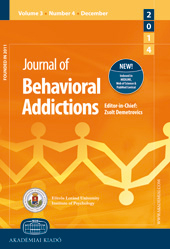A critical review of “Internet addiction” criteria with suggestions for the future
A critical review of “Internet addiction” criteria with suggestions for the future
Author(s): Antonius J. Van Rooij, Nicole PrauseSubject(s): Psychology, Neuropsychology, Behaviorism, Methodology and research technology, Substance abuse and addiction, Health and medicine and law, ICT Information and Communications Technologies
Published by: Akadémiai Kiadó
Keywords: Internet use disorder; Internet addiction; diagnostic criteria; DSM-5; behavioral addiction; addictive disorders;
Summary/Abstract: In the last 5 years a deluge of articles on the topic of Internet addiction (IA) has proposed many candidate symptoms as evidence of this proposed disease. We critically reviewed the current approach to the measurement and identification of this new excessive behavior syndrome. Methods: Three popular models of IA were discussed: Griffith’s components model; Young’s Internet Addiction Test (IAT); and the criteria by Tao et al. (2010). We selected these models because they are widely cited and propose specific criteria for IA disorder. Our approach is not meant to provide an exhaustive review, but to discuss and critique the most salient trends in the field. Results: The models of Internet addiction share some criteria, including feeling a loss of control over Internet use; ensuing psychological, social, or professional conflict or problems; and preoccupation when not using the Internet. Other criteria inconsistently mentioned include: mood management, tolerance, withdrawal, and craving/anticipation. The models studied here share the assumption that the Internet can produce a qualitative shift to a diseased state in humans. Conclusions: We critically discussed the above criteria and concluded that the evidence base is currently not strong enough to provide support for an Internet addiction disorder. Future research areas are suggested: (1) Focusing on common impaired dimensions, (2) exploring neuroimaging as a model building tool, and (3) identifying shifts in the rewarding aspects of Internet use. Given the lack of consensus on the subject of Internet addiction, a focus on problem behaviors appears warranted.
Journal: Journal of Behavioral Addictions
- Issue Year: 3/2014
- Issue No: 4
- Page Range: 203-213
- Page Count: 11
- Language: English

